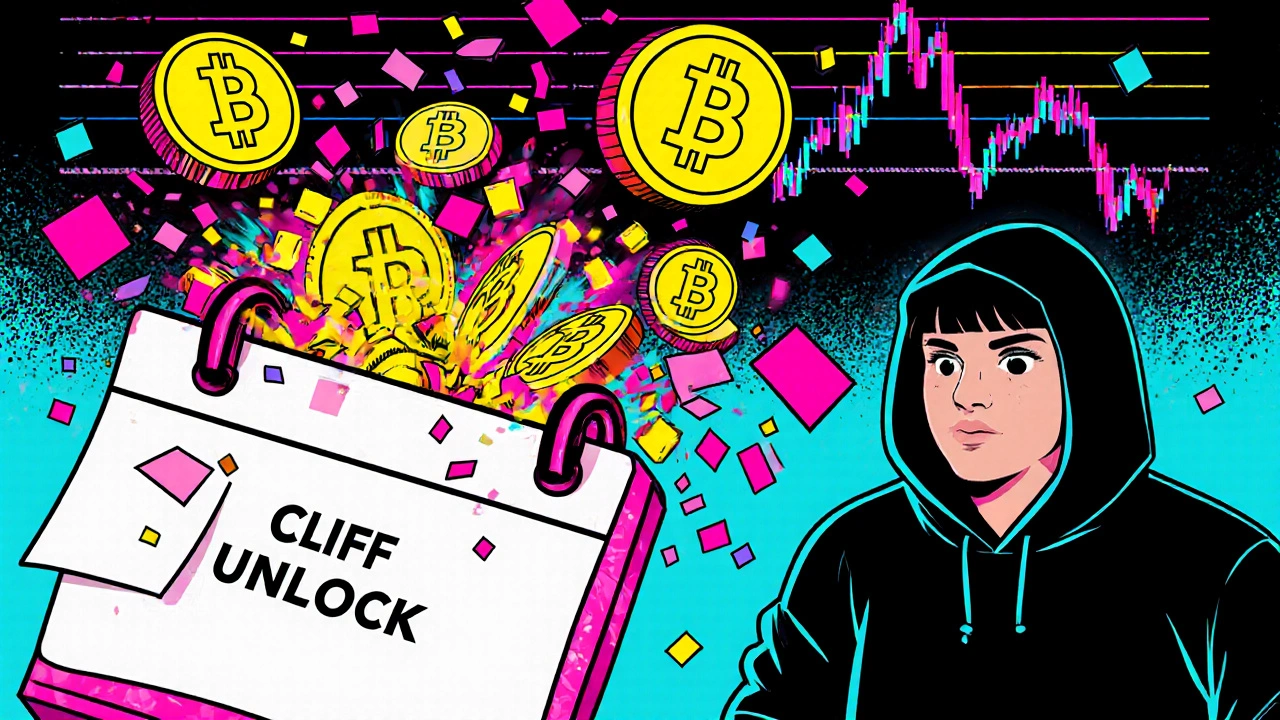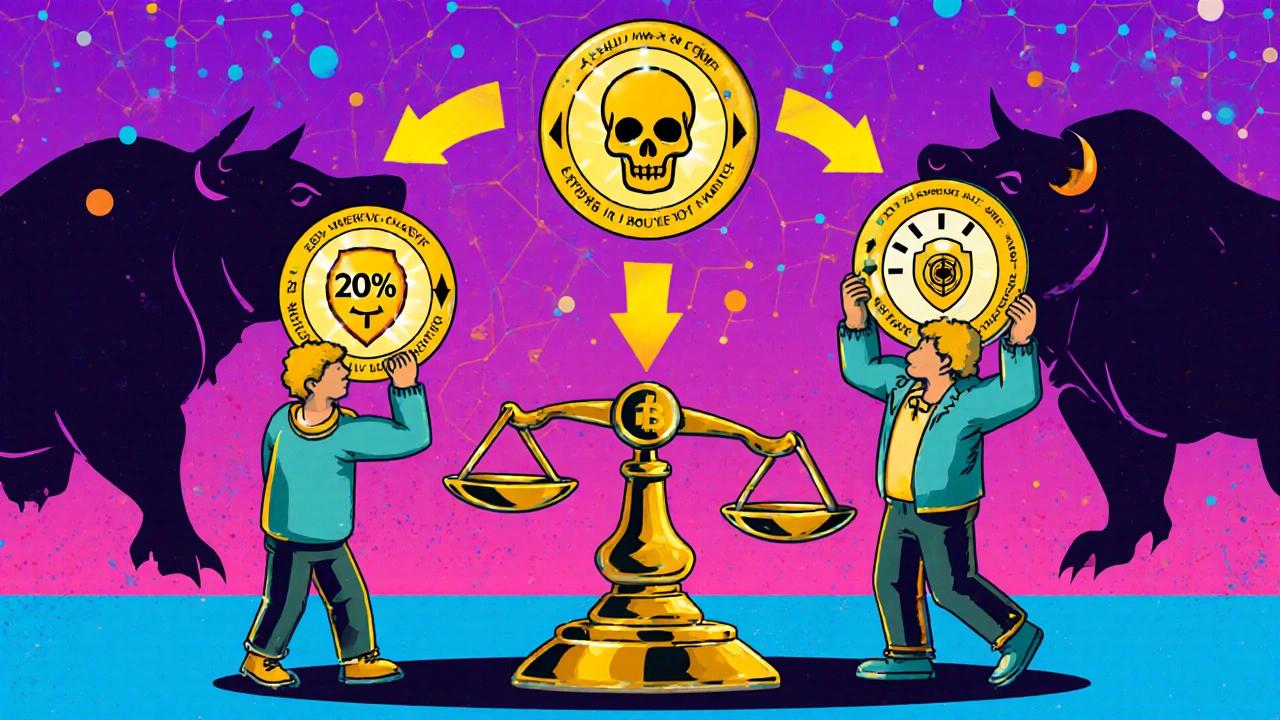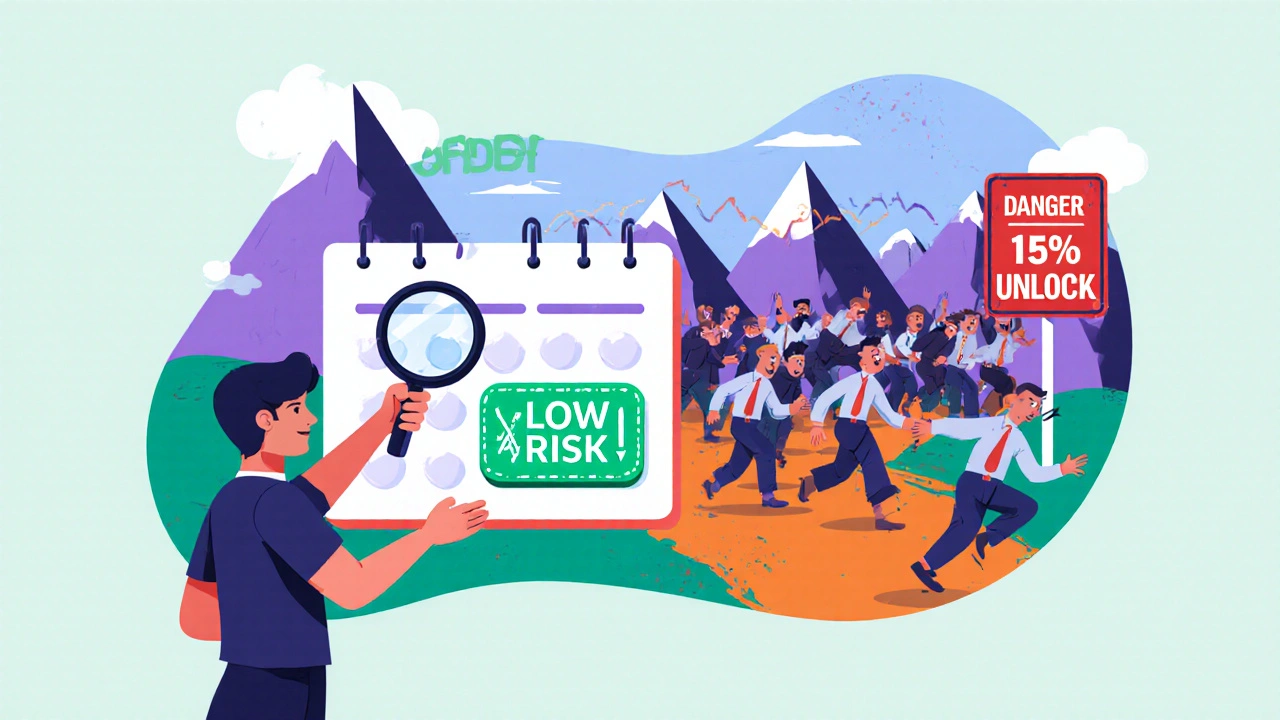Token Unlock Calendars for Altcoins: How They Move Prices and What to Do About It
 Nov, 20 2025
Nov, 20 2025
When a new altcoin launches, it’s easy to get excited. But if you’re holding tokens, you’re not just betting on the project-you’re betting on when and how those tokens hit the market. That’s where token unlock calendars come in. These aren’t just calendars. They’re warning signs, profit opportunities, and sometimes, price bombs waiting to go off.
Every altcoin project locks up a big chunk of its tokens at launch. Why? To stop early investors from dumping everything the second trading starts. That’s smart in theory. But when those locked tokens finally unlock, they flood the market. And if you don’t see it coming, you get crushed.
What Exactly Is a Token Unlock?
A token unlock is when tokens that were locked in a smart contract suddenly become tradable. These tokens belong to team members, early investors, or ecosystem funds. They’re not meant to be sold right away. But when the unlock date hits, they can be-often all at once.
Most projects use vesting schedules. Think of it like a salary paid in crypto instead of cash. For example, a team might get 25% of their tokens after one year, then 1/48th every month after that. That’s a linear unlock. Others get nothing for 12 months, then 30% drops into their wallets all at once. That’s a cliff unlock. And cliff unlocks? They’re the ones that make traders panic.
Projects like ALT and TRUMP Token showed how brutal this can be. ALT unlocked 20% of its total supply in a single day. Price dropped 19.2% over three days. TRUMP Token’s unlock just before the U.S. election triggered a 23.7% crash as big holders cashed out. These aren’t rare cases. They’re the norm when unlocks are poorly structured.
Why Some Unlocks Crash Prices-And Others Don’t
Not all unlocks are created equal. The size matters more than the date.
If a project unlocks less than 1% of its circulating supply, the market barely notices. But if it’s over 5%? That’s a red flag. ChainCatcher’s data shows these big unlocks cause a median 12.4% price drop within 30 days. Why? Because the supply suddenly doubles or triples overnight. Sellers outnumber buyers. And in crypto, that’s a recipe for a crash.
Who gets the tokens matters too. Seed investors-those who put money in during the earliest rounds-have a history of selling fast. Their unlocks cause 15.3% more volatility than team or community unlocks. Team members? They’re more likely to hold. Their tokens are often locked for 2-4 years. That’s a good sign. It means they believe in the project long-term.
Market conditions play a role too. In a bull market, buyers are hungry. They can absorb bigger unlocks. In a bear market? Even a 2% unlock can trigger a 10% drop. Timing isn’t just about the calendar. It’s about the mood of the whole market.
When the Price Starts Moving-Before the Unlock
Here’s something most new traders miss: the price starts dropping weeks before the unlock. Not on the day. Not even a day before. Sometimes 30 days out.
Dr. Jane Chen’s 2024 study found that volatility spikes 1.7 days before the unlock. But smart money starts moving much earlier. Why? Because they know what’s coming. They see the unlock calendar. They know the size. They know the recipients. So they sell ahead of time.
This is why you can’t wait until the day of the unlock to act. By then, it’s too late. The big players have already exited. You’re left holding the bag as the price slides.
One trader on CryptoTwitter, @AltcoinAlpha, avoided a 28.3% loss by selling 21 days before a 15% supply unlock. He didn’t guess. He checked the calendar. He calculated the percentage. He knew what history showed. That’s the difference between guessing and trading.

How to Track Token Unlocks Like a Pro
You can’t manage what you can’t see. That’s why tracking tools are non-negotiable.
Here are the top three platforms used by serious traders:
- CryptoRank.io - Used by 73% of active traders on Reddit. Free tier gives basic data. Pro version ($49/month) shows recipient breakdowns, historical impact, and alerts.
- token.unlocks.app - Popular for its clean interface. But 42% of users complain about 12-48 hour delays. Don’t rely on this for last-minute decisions.
- Bitget Wallet - Integrated calendar with AI predictions. Its October 2024 update scores upcoming unlocks by risk level. It got 76.3% accuracy in backtesting.
Don’t trust project websites alone. Only 37% of altcoins publish clear vesting schedules in their whitepapers. You need to cross-check with blockchain explorers like Etherscan. Look for the smart contract addresses. See how many tokens are being released. Who controls them? If you can’t find it, assume the worst.
Your Action Plan: 5 Steps to Survive Token Unlocks
Here’s what to do when you spot a big unlock coming:
- Check the size. Is it over 5% of circulating supply? If yes, treat it like a warning siren.
- Find the recipient. Is it seed investors? Team? Ecosystem fund? Investors sell faster. Team members hold longer.
- Look at the schedule. Is it a cliff? Or linear? Cliff unlocks = high risk. Monthly unlocks = manageable.
- Check the market. Is crypto in a bull run? Then the drop might be shallow. Bear market? Prepare for a plunge.
- Act early. Reduce your position 14-21 days before the unlock. Don’t wait. Don’t hope. Exit before the crowd does.
One user on CryptoSlate lost $8.7 million holding through a 22% supply unlock. He didn’t hedge. He didn’t reduce. He just held. BitMEX Research says: if an unlock exceeds 5%, hedge your position. That means selling part of your stake, or using derivatives to protect against downside.

The New Tools: Hedging and AI Predictions
Smart traders aren’t just reacting anymore. They’re preparing.
Deribit reported $127 million in unlock-specific options contracts traded in Q3 2024. These are bets that let you profit if the price drops after an unlock-even if you still hold the token. It’s insurance. And it’s growing fast.
AI tools are catching up too. Bitget’s system now predicts unlock impact with 76.3% accuracy. Messari is testing sentiment analysis to forecast price moves before the unlock even happens. The future isn’t just watching calendars. It’s predicting them.
Projects are also getting smarter. In 2024, 41% of new altcoins tied unlocks to real milestones-like launching a mainnet or hitting 100,000 users. That’s better than a fixed calendar. It means tokens unlock only when the project is ready. Less panic. More stability.
What’s Next for Token Unlocks?
Token unlocks are here to stay. But they’re changing.
Regulators are watching. The SEC’s 2024 ‘Project Token Vesting’ initiative wants unlock schedules filed with token sales. That means more transparency. Less hiding.
And markets are learning. In 2021, only 67% of projects used structured vesting. Now it’s 92%. Investors know better. They won’t touch a project that dumps 30% of its supply on day one.
By 2027, experts at Delphi Digital predict unlock-related volatility will drop by 33.7%. Why? Because traders will have seen it all before. They’ll know how to react. The shock value fades.
But until then? Unlocks are still the most dangerous moment in an altcoin’s life. Not because the project fails. But because the market reacts.
Final Thought: Don’t Trade the Hype. Trade the Calendar.
Altcoins don’t die from bad tech. They die from bad tokenomics. And the biggest red flag? A massive, poorly timed unlock.
If you’re holding an altcoin, you owe it to yourself to know when its tokens are coming out. Check the calendar. Know the size. Know the players. Act before the crowd.
Because in crypto, the best trades aren’t the ones you make when everyone’s excited. They’re the ones you make when everyone else is blind.
What happens to the price after a token unlock?
After a token unlock, price usually drops-especially if the unlock is large (over 5% of circulating supply) or comes from seed investors. The drop happens because new tokens flood the market, and sellers often outnumber buyers. On average, unlocks over 5% cause a 12.4% price decline within 30 days. But if the unlock is small (under 1%) or happens in a strong bull market, the impact can be minimal or even positive.
Are token unlocks always bad for the price?
No. Not all unlocks are bad. Linear unlocks spread over months cause less shock than big cliff unlocks. If the project is strong and the tokens go to team members or ecosystem funds (not investors), the market may absorb the supply without a crash. Some projects even see price gains if the unlock signals progress-like a mainnet launch tied to the release.
How far in advance should I sell before a token unlock?
Sell 14-21 days before a major unlock (over 5% of supply). Price often starts falling weeks ahead as big holders exit. Waiting until the day of the unlock means you’re likely the last one holding. Traders who act early avoid the worst drops-like one user who saved 28.3% by selling 21 days before a 15% unlock.
Which tools are best for tracking token unlocks?
CryptoRank.io is the most trusted, used by 73% of active traders. Bitget Wallet offers AI-powered risk scores and real-time alerts. token.unlocks.app is free but often delayed by 12-48 hours. For accuracy, combine these with blockchain explorers like Etherscan to verify unlock details yourself.
Can I hedge against a token unlock?
Yes. Deribit and other platforms now offer unlock-specific options contracts. These let you profit if the price drops after the unlock-even if you keep your tokens. This is called hedging. It’s becoming popular among professional traders, with $127 million in notional value traded in Q3 2024 alone.
Why do some projects have cliff unlocks instead of linear ones?
Cliff unlocks are often used to incentivize long-term commitment. Team members and investors get nothing for the first 6-12 months, then get a large batch. The idea is to keep them focused on building the project before they can sell. But in practice, cliff unlocks create massive sell pressure and are seen as risky by the market. Smart projects are moving away from them.
Is it safe to buy an altcoin right after a big unlock?
It’s risky. After a big unlock, the price is often still falling. Sellers may keep dumping for days or weeks. Wait until volatility settles-usually 14-30 days after the unlock. Look for signs of strong demand returning, like rising trading volume and price support. Don’t assume the bottom is in just because the unlock is over.
